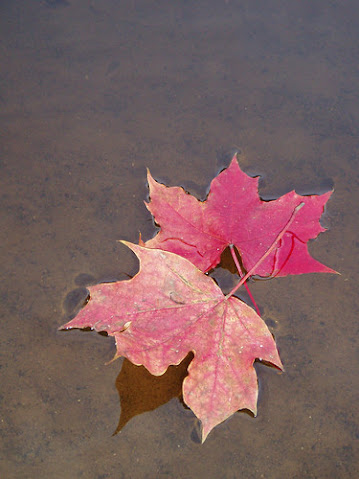The Journey of a Drifting Leaf: An
Exploration of Nature's
Resilience and Connectivity
In the quiet embrace of autumn, as
trees don their cloaks of gold, crimson, and amber, leaves embark on a journey
that is both enchanting and poignant. Among these leaves is a solitary maple
leaf, vibrant in hue but ripe for release. This essay is a narrative
exploration of the leaf's journey, drawing parallels to the ecosystems it
traverses and the broader themes of resilience, interconnectedness, and the
cycle of life inherent in nature.
As the crisp autumn air sweeps
through the forest, the timeworn branches of the maple tree begin to yield to
gravity, releasing their once-vibrant offspring. The leaf, now liberated,
flutters through the brisk wind, its descent gentle yet erratic—a microcosm of
life itself. In its fall, the leaf embodies the natural process of decay and
renewal. It acts as a vessel for nutrients, which will ultimately return to the
earth, fostering new growth in the seasons to come.
The Descent: A Journey Begins
Our drifting leaf, now caught in an
involuntary ballet with the wind, seems to embrace its newfound freedom while
also experiencing trepidation. It spirals and twirls, momentarily caught in the
swirling eddies of a gentle breeze, reminiscent of how we, too, navigate life’s
uncertainties. This aspect of the leaf's journey resonates with the story of
the dandelion seed, which, buoyed by the wind, travels great distances from its
parent plant. In this way, the maple leaf’s descent is paradoxical; while it is
a release from the tree, it also marks the beginning of another chapter in its
ecological narrative.
As our leaf touches the ground, it
joins a vibrant tapestry of organic matter, including fallen acorns, discarded
pine needles, and fragments of bark, illustrating a community formed from
decay. Each type of debris serves a purpose: acorns sprout into mighty oaks,
while pine needles contribute to the soil's acidity, facilitating diverse plant
life. The interconnectedness of these natural elements provides a foundation
for understanding life’s cyclical nature.
The Forest Floor: An Ecosystem of
Renewal
Lying amidst this organic ensemble,
the leaf enters its next phase of existence. The forest floor, cloaked in
layers of decomposing matter, becomes a microhabitat for a plethora of
organisms. Earthworms wriggle beneath the surface, processing the organic
material and enhancing soil aeration. Fungi, with their vast networks of
mycelium, begin to break down the leaf, transforming it into rich humus, a
life-giving substance that nourishes future flora.
This phase of the leaf’s journey
exemplifies resilience. It demonstrates how even in death, life sustains; how
components of an ecosystem play vital roles in maintaining balance. Just as a
fallen leaf contributes to the cycle of renewal, humans, too, have roles within
their communities—whether through mentorship, knowledge-sharing, or
environmental stewardship. The leaf’s decomposition process mirrors human
development, underscoring that growth often arises from the remnants of what
has already passed.
The Role of the Leaf in the Greater
Ecosystem
As winter approaches, the leaf, now
a mere ghost of its former self, continues to serve a purpose, albeit in a more
subdued manner. It provides shelter for overwintering insects and serves as
insulation for the soil, safeguarding the roots of nearby plants from the
harsh, freezing temperatures. Through this sheltering role, the leaf
underscores a fundamental truth in nature: every entity has intrinsic value
within its ecosystem.
The leaf's journey touches upon the
themes of struggle, growth, and eventual reconciliation with the natural world.
In observing the seasonal cycle of life and death, one cannot help but draw
parallels with the human experience. Much like the leaf, individuals face
changes, transitions, and inevitable endings that ultimately lead to new
beginnings.
Spring Awakening: A New Generation
As spring unfurls its vibrant
tapestry, the forest awakens from its slumber, bursting forth in a riot of
color and life. The nutrients released from the decaying leaf have nourished
the soil, fostering the growth of eager seedlings vying for sunlight. These new
life forms—wildflowers, grasses, and saplings—debunk the notion of isolation in
death. The maple leaf’s journey culminates here: in the promise of new life
that emerges from its sacrifice.
Analogous to the leaf’s
transformation into nutrients, our experiences, often marred by loss or change,
serve as precious lessons that nurture growth and inspiration. This cyclical
view of existence—where endings are intrinsically linked to new
beginnings—echoes through both human lives and nature itself.
Conclusion: Nature's Unending
Tapestry
The journey of the drifting leaf
encapsulates the essence of nature’s resilience and interconnectedness. It
serves as a reminder that every element within an ecosystem plays a pivotal
role, contributing to the delicate balance of life. The leaf embodies the
spirit of transformation; its descent from the lofty branches to the forest
floor celebrates both the beauty and the inevitability of change.
As we ponder the maple leaf’s
voyage, we are invited to reflect on our own journeys—acknowledging that every
chapter, every variant of experience contributes to the broader story of
existence. Nature’s narratives, intricate and profound, serve as metaphors for
our lives, reminding us that within each ending lies the seed of a new
beginning. The drifting leaf, though once vibrant and alive, ultimately plays a
crucial role in the regeneration of life, declaring that every journey, however
brief, enriches the tapestry of our world.
And in the end read this poem… you
will enjoy the journey of a leaf
In crisp autumn air, a whisper
sweeps,
Through amber leaves where the old
oak keeps,
As shadows dance in the fading
light,
The journey begins, a seasonal
flight.
Each branch adorned with hues of
gold,
Tells stories of seasons, silent yet
bold.
In the heart of the forest, an
ecosystem thrives,
Where life interweaves, and nature survives.
Beneath a blanket of rustling
leaves,
The roots intertwine, as each
creature weaves,
A tapestry of whispers, of tales
deeply spun,
Where hope springs eternal, like the
morning sun.
Then comes spring awakening, soft
and bright,
With tender blooms that emerge from
the night,
Petals unfolding, their fragrance a
song,
In the symphony of life, where all
beings belong.
Love dances lightly on the wings of
the breeze,
As butterflies flutter through
cherry blossom trees,
In every corner of the thriving
glade,
The bonds of existence are lovingly
laid.
So let us roam through this vibrant
expanse,
Feel the pulse of the earth in a
timeless dance,
For in nature's embrace, we find our
way,
Through the crisp autumn air to
another day.


.jfif)

.jfif)





.jfif)
.jfif)
.jfif)



.jfif)

